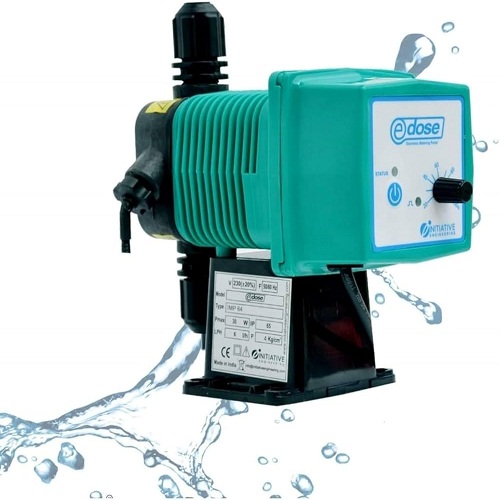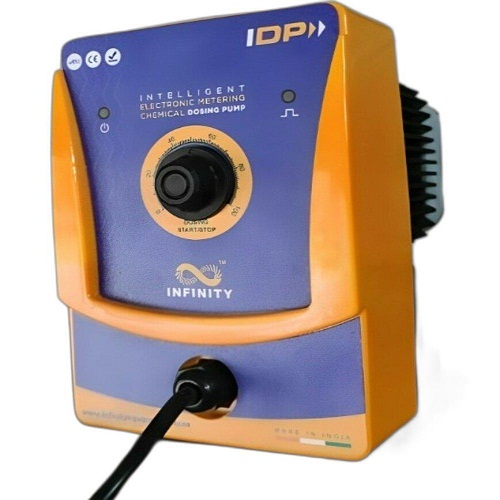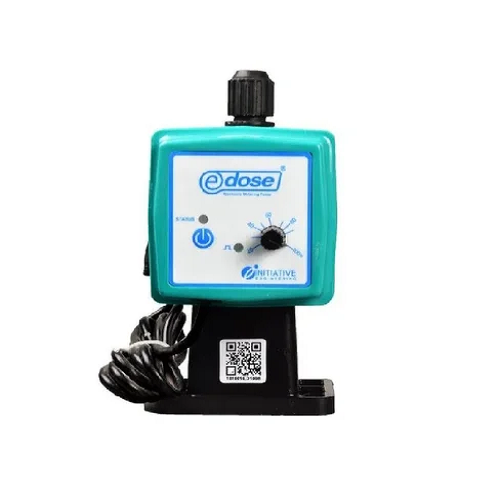
our category
DOSING PUMP
Dosing Pump: Overview, Functionality, and Applications
A dosing pump is a precision pump used to add a specific volume of a liquid, such as a chemical, preservative, or additive, into a system. Dosing pumps are designed to provide accurate and controlled dosing of liquids to meet the exact requirements of various processes. These pumps are commonly used in industries such as water treatment, chemical processing, pharmaceuticals, food and beverage, and agriculture, where precise chemical dosing is crucial for the efficiency, safety, and effectiveness of operations.
Enquire Now
What is a Dosing Pump?
A dosing pump is a mechanical device used to deliver a specific, measured quantity of a chemical or other liquid over a given period of time. Unlike other pumps that may move large quantities of fluid at varying rates, dosing pumps are designed to deliver a constant flow rate or volume at a precise dosage.
The dosing process is typically controlled either manually or automatically, with the pump dispensing the exact amount of liquid necessary to achieve the desired concentration in the system.
Types of Dosing Pumps
There are several types of dosing pumps, each suited for different applications based on the type of fluid, flow rate, and control mechanism required. The primary types of dosing pumps are:
-
Diaphragm Dosing Pumps:
- Diaphragm pumps are the most common type of dosing pump. They use a flexible diaphragm to create pressure and displacement, delivering precise volumes of liquid. The diaphragm moves back and forth to draw liquid into the pump and then pushes it out to the system. These pumps are ideal for handling chemicals that may be corrosive, abrasive, or toxic.
- Advantages: Accurate dosing, minimal maintenance, ideal for high-viscosity fluids.
- Applications: Water treatment, chemical dosing, and pharmaceutical applications.
-
Peristaltic Dosing Pumps:
- Peristaltic pumps work by using a rotating roller to squeeze a flexible tube, moving the liquid through it. The amount of liquid pumped is determined by the speed of the rollers and the size of the tube. These pumps offer excellent accuracy and are ideal for dispensing viscous or aggressive liquids.
- Advantages: Ideal for high-precision dosing, self-priming, can handle viscous and aggressive chemicals.
- Applications: Pharmaceutical, food and beverage, and laboratory dosing.
-
Plunger Dosing Pumps:
- Plunger pumps utilize a plunger or piston mechanism to force liquid through the pump. The plunger moves in a reciprocating motion, creating a vacuum to draw the liquid into the chamber and then discharges it into the system under pressure. These pumps are commonly used for high-pressure dosing applications.
- Advantages: High pressure, precision dosing, long service life.
- Applications: Chemical industries, high-pressure water treatment.
-
Gear Dosing Pumps:
- Gear pumps use interlocking gears to move the liquid. The liquid is trapped between the gears and transferred from the inlet to the outlet. These pumps are often used for dosing viscous fluids or liquids that need to be dispensed at a constant rate.
- Advantages: Consistent flow, ideal for handling high-viscosity liquids.
- Applications: Oil and lubricant dosing, food and beverage industry, and industrial applications.
-
Rotary Dosing Pumps:
- Rotary pumps use a rotating mechanism to transfer liquid from the inlet to the outlet. They are known for their precise flow control and ability to handle high viscosity liquids.
- Advantages: High flow rates, excellent for continuous dosing.
- Applications: Chemical processing, water treatment, and oil industries.
Key Features of Dosing Pumps
-
Flow Control: Dosing pumps are designed to deliver precise amounts of liquid. Many dosing pumps come with adjustable flow rates, which allow for accurate measurement of chemical dosages. The flow rate can be controlled manually or via automatic systems, such as flow meters or controllers, depending on the application.
-
High Precision: The primary function of a dosing pump is to ensure that exact amounts of liquid are injected into a system. This precision is critical in applications where small variations in dosing can result in significant changes in process outcomes, such as in water treatment or pharmaceutical manufacturing.
-
Safety Features: Dosing pumps often come with various safety features, such as overflow protection, pressure relief valves, and anti-drip mechanisms. These features ensure that the system operates efficiently without over- or under-dosing, which could lead to inefficiencies or hazardous conditions.
-
Adjustable Dosage: Many dosing pumps allow users to adjust the dosage according to the system’s requirements. The dosing volume can be set through the pump’s control interface or via external controllers to ensure the proper amount of liquid is added.
-
Material Compatibility: Dosing pumps are designed with materials that can withstand different liquids, including corrosive chemicals and highly viscous fluids. The materials for the pump’s construction (such as stainless steel, ceramics, and PTFE seals) depend on the type of liquid being dosed.
Applications of Dosing Pumps
-
Water Treatment: Dosing pumps are commonly used in water treatment plants to add chemicals like chlorine, flocculants, and pH adjusters to water to make it safe for drinking or industrial use. Precision dosing is essential to ensure the right concentration of chemicals is added.
- Disinfection: Dosing pumps inject disinfectants like chlorine or ozone to kill bacteria and other microorganisms in the water supply.
- pH Adjustment: Dosing pumps add chemicals like acids or alkalis to adjust the pH of the water.
- Flocculation: Dosing pumps add flocculants to bind particles in the water, making it easier to remove impurities.
-
Chemical Processing: Dosing pumps are crucial in the chemical industry, where chemicals are dosed into reactors, mixers, or pipelines for various processes. Whether it’s for adding catalysts, solvents, or reactants, accurate dosing ensures that the chemical reactions occur as intended.
- Acid/Base Dosing: Used in processes that require precise dosing of acids or bases to maintain the desired chemical balance.
- Additive Dosing: Used for the addition of additives in chemical manufacturing, including colorants, stabilizers, or plasticizers.
-
Food and Beverage Industry: In food and beverage manufacturing, dosing pumps are used for adding flavors, preservatives, and sweeteners in accurate quantities. They ensure that ingredients are added in the correct proportions to maintain product quality and consistency.
- Flavor and Preservative Dosing: Dosing pumps ensure that flavorings, preservatives, and other additives are added precisely during production.
- Ingredient Addition: Used for dosing ingredients like oils, syrups, and emulsifiers in the production of sauces, beverages, or processed foods.
-
Pharmaceutical Industry: Dosing pumps are essential in the pharmaceutical sector for precise dispensing of medications and active ingredients in drug formulation processes. These pumps are designed to meet strict quality control standards, ensuring the proper dosage is administered in the manufacturing of medicinal products.
- Active Ingredient Dosing: Dosing pumps are used to add precise amounts of active pharmaceutical ingredients (APIs) into formulations.
- Sterility and Cleanliness: Dosing pumps used in pharmaceuticals must meet high standards of hygiene, with easy cleaning and sterilization.
-
Agriculture: In agriculture, dosing pumps are used for the precise application of fertilizers, pesticides, and herbicides. These pumps allow for consistent and accurate delivery of chemicals to crops, reducing waste and ensuring optimal growth conditions.
- Fertilizer Dosing: Dosing pumps precisely inject liquid fertilizers into irrigation systems for efficient nutrient delivery.
- Pesticide Application: Dosing pumps are used in pesticide spraying systems to ensure that the right amount of chemical is applied to crops.
Advantages of Dosing Pumps
-
Precision and Accuracy: Dosing pumps offer precise control over the volume of liquid dispensed, making them suitable for applications where exact dosages are critical.
-
Efficiency: By delivering the right amount of chemicals at the right time, dosing pumps help optimize processes and reduce waste, resulting in cost savings.
-
Versatility: Dosing pumps are used in a wide range of industries, from water treatment and pharmaceuticals to agriculture and food processing, making them versatile tools for many applications.
-
Cost-Effective: Dosing pumps ensure the efficient use of chemicals and additives, minimizing overuse and ensuring that resources are utilized effectively.
-
Ease of Control: Many dosing pumps are equipped with adjustable flow settings and automatic control systems, making it easy to set and adjust the dosage according to specific requirements.
Conclusion
Dosing pumps are vital for achieving precise chemical dosing and liquid control across a wide variety of industries. Their ability to accurately and consistently add the required amounts of substances ensures optimal performance in processes like water treatment, chemical manufacturing, food processing, and agriculture. With advancements in technology, modern dosing pumps provide enhanced efficiency, ease of use, and safety, making them indispensable in many sectors where exact dosing is essential.


